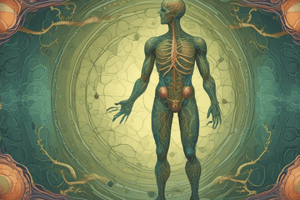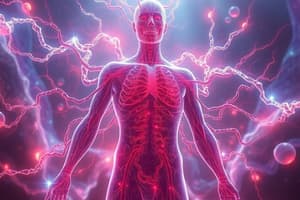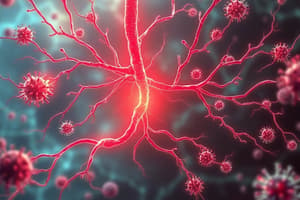Podcast
Questions and Answers
List the general functions of the lymphatic system.
List the general functions of the lymphatic system.
The lymphatic system removes interstitial fluid from tissues, absorbs and transports fatty acids and fats as chyle from the digestive system, and transports white blood cells to and from the lymph nodes into the bones.
Describe the difference between thoracic duct and right lymphatic duct.
Describe the difference between thoracic duct and right lymphatic duct.
The right lymphatic duct drains lymph from the right upper limb, right side of the thorax, and right halves of the head and neck, while the thoracic duct drains lymph into the circulatory system at the left brachiocephalic vein.
Describe the lymphatic pathway.
Describe the lymphatic pathway.
Lymph flows from lymphatic vessels into lymphatic trunks and finally into collecting ducts where it is disposed into the subclavian veins.
Describe the major functions of lymph.
Describe the major functions of lymph.
Describe the factors that promote lymph flow.
Describe the factors that promote lymph flow.
Describe the consequences of lymphatic obstruction.
Describe the consequences of lymphatic obstruction.
Distinguish between a lymph node and lymph nodule.
Distinguish between a lymph node and lymph nodule.
Describe the major function of a lymph node.
Describe the major function of a lymph node.
Describe the functions of the thymus and spleen and why they are considered organs of the lymphatic system.
Describe the functions of the thymus and spleen and why they are considered organs of the lymphatic system.
Describe an infection and the seven innate defense mechanisms.
Describe an infection and the seven innate defense mechanisms.
Describe immunity.
Describe immunity.
Describe the difference between an antigen and a hapten.
Describe the difference between an antigen and a hapten.
Describe how T cells and B cells originate.
Describe how T cells and B cells originate.
Flashcards are hidden until you start studying
Study Notes
Functions of the Lymphatic System
- Responsible for removal of interstitial fluid from tissues.
- Absorbs and transports fatty acids and fats from the digestive system as chyle.
- Transports white blood cells to and from lymph nodes and bones.
Thoracic Duct vs. Right Lymphatic Duct
- Right lymphatic duct drains lymph from the right upper limb, right thorax, and right halves of head and neck.
- Thoracic duct drains lymph into the circulatory system at the left brachiocephalic vein, situated between the left subclavian and left internal jugular veins.
Lymphatic Pathway
- Lymph flows from lymphatic vessels to lymphatic trunks and then to collecting ducts, ultimately emptying into subclavian veins.
- Lymphatic vessels run parallel to blood capillaries, facilitating the diffusion of tissue fluid into the lymphatic pathway.
Major Functions of Lymph
- A network of tissues and organs that helps eliminate toxins, waste, and unwanted materials from the body.
- Transports lymph, a fluid rich in infection-fighting white blood cells, throughout the body.
Factors Promoting Lymph Flow
- Rate of lymph formation significantly influences lymph flow.
- Increased blood capillary pressure, due to arterial vasodilation or venous constriction, causes an uptick in lymph flow.
- Valves in lymph vessels prevent retrograde flow, akin to venous valves.
Consequences of Lymphatic Obstruction
- Blockage in lymph vessels that drains fluid and allows immune cells to circulate can lead to lymphedema.
- Lymphedema is characterized by swelling resulting from such blockages.
Lymph Node vs. Lymph Nodule
- Lymph nodules are smaller and lack a well-defined connective-tissue capsule compared to lymph nodes.
- Lymph nodules do not filter lymph and are typically not located along lymphatic vessels; collections in the small intestine are known as Peyer's patches.
Major Functions of Lymph Nodes
- Filter lymph and support the immune system in mounting an immune response.
- Lymph is derived from blood plasma that exits blood vessels and becomes interstitial fluid surrounding cells.
Functions of Thymus and Spleen
- The thymus produces T-lymphocytes essential for immune response and secretes thymosin to mature T-lymphocytes.
- The spleen, the largest lymphatic organ, mimics a large lymph node and consists of lobules or chambers, playing a crucial role in the lymphatic system.
Infection and Innate Defense Mechanisms
- Infection refers to the process of being infected by pathogens.
- Seven innate defense mechanisms include:
- Physical barriers
- Chemical barriers
- Cellular defenses
- Inflammation
- Fever
- Molecular defenses
Immunity
- Describes the ability of an organism to resist specific infections or toxins through antibodies or sensitized white blood cells.
Antigen vs. Hapten
- Antigens can initiate an immune response and are both antigenic and immunogenic, while haptens are smaller molecules that only exhibit antigenic properties when paired with a carrier.
Origin of T Cells and B Cells
- Both T cells and B cells originate from lymphocytes (white blood cells).
- They start in the bone marrow, migrating to lymphatic structures such as lymph nodes, spleen, and thymus, where they gain receptors to recognize foreign substances.
Studying That Suits You
Use AI to generate personalized quizzes and flashcards to suit your learning preferences.





